They are named Alien Betta for a reason: Their beauty is beyond this world!
Do you find yourself intrigued by their vibrant patterns, yet uncertain about their care requirements? If yes, dive into our comprehensive guide about, “Alien Betta Fish”, and unlock the secrets to ensuring these mesmerizing inhabitants thrive in your care.
Alien Betta Fish Facts & Overview
| Common Names | Alien Betta Fish |
| Scientific Name | Betta splendens |
| Adult Size | 2.5 inches (6.35 cm) |
| Lifespan | 2-4 years |
| Family | Osphronemidae |
| Origin | Southeast Asia |
| Social | Solitary |
| Minimum Tank Size | 5 gallons (19 liters) |
| Diet | Carnivorous |
| Prey | Insects, larvae, small crustaceans |
| Group Behavior | Aggressive |
| Habitat | Shallow waters, rice paddies |
| Color | Various colors and patterns |
| Skin Type | Scales |
| Care | Moderate |
| Breeding | Bubble nest builder, paternal care |
| pH | 6.0 – 7.5 |
| Water Hardness | Soft to medium |
| Temperature | 75 – 80°F (24 – 27°C) |
| Favorite Food | Live or frozen insects, brine shrimp |
Alien Betta Origin and Distribution
Bettas hail from the tranquil shallow waters across Southeast Asia, covering countries such as Thailand, Indonesia, Malaysia, Vietnam, and parts of China. The name ‘Betta’ often brings to mind their historical link to Siam, now known as Thailand.
Their natural habitats are as captivating as the fish themselves; imagine them gracefully swimming amongst the vast rice paddies, serene ponds, and the gentle currents of slow-moving streams and swamps.
The allure of Bettas has seen them introduced to various locations worldwide, leading to them establishing non-native populations in several countries. This speaks volumes about their adaptability and the universal appeal they hold.
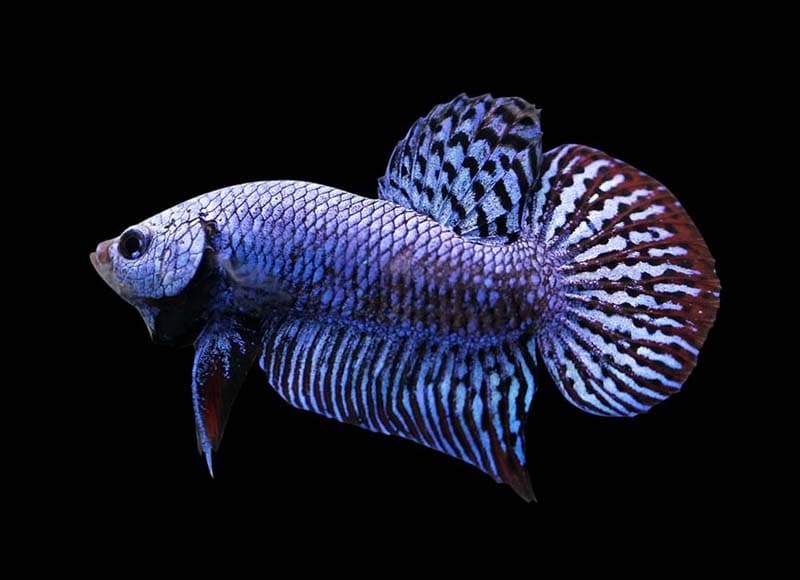
Typical Behavior of Alien Betta
Territorial Instincts: The male alien betta is inherently territorial. His aggressive tendencies arise mainly from a protective instinct, making him likely to see other male bettas as adversaries. This behavior is rooted in the belief that another male might encroach on his territory, prompting him to defend his space assertively.
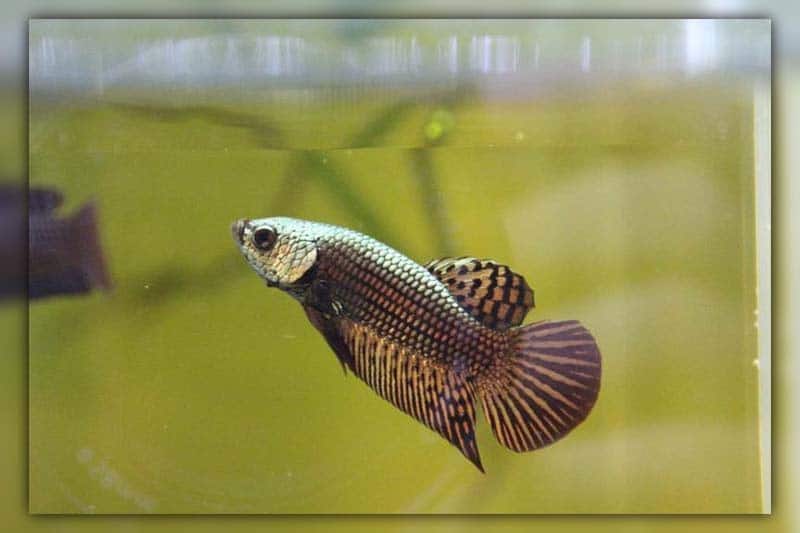
Given their territorial nature, providing a separate tank for your alien betta can often be a wise decision. This personal space lets him swim and roam without the stress of potential competition.
Interpreting Their Movements: Your alien betta’s swimming patterns can be quite telling. Gentle, fluid movements signify contentment and relaxation. On the other hand, rapid, erratic swimming might indicate that your betta feels threatened or uneasy.
Appearance & Color
The alien betta is truly a types of betta fish with its myriad of hues. Typically characterized by a vivid base of bright green, yellow, red, grey, black orange, or purple, its beauty doesn’t stop there. Layered atop these vibrant shades is a shimmery pattern of black or brown stripes, lending it a distinctive and mesmerizing appearance.
Equally noteworthy are its striking tail and fins. These bright appendages cascade gracefully through the water, accentuating the alien betta’s serene and elegant swim patterns.
Image blue alien betta
Image alien crowntail betta fish
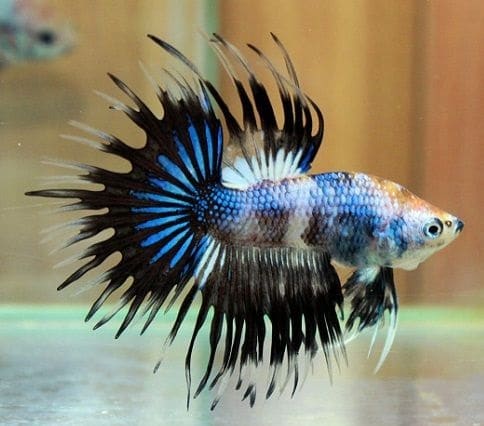
Image alien halfmoon betta
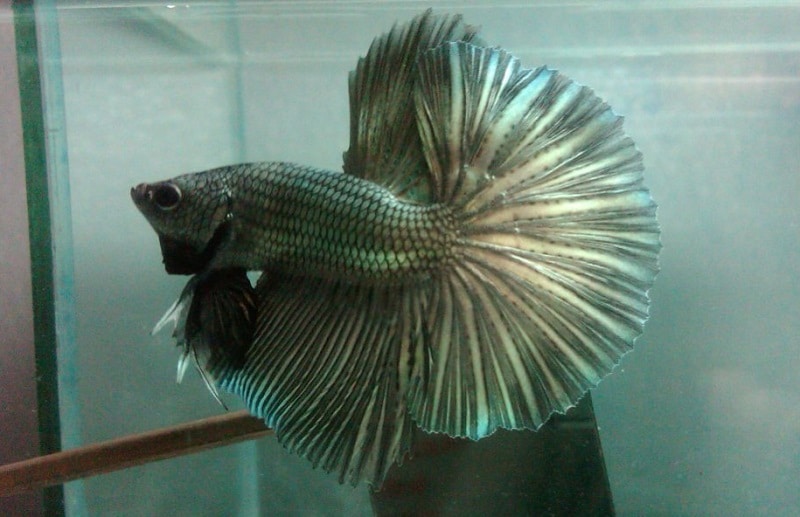
Image copper alien betta
Image green alien betta
Image grey alien betta fish
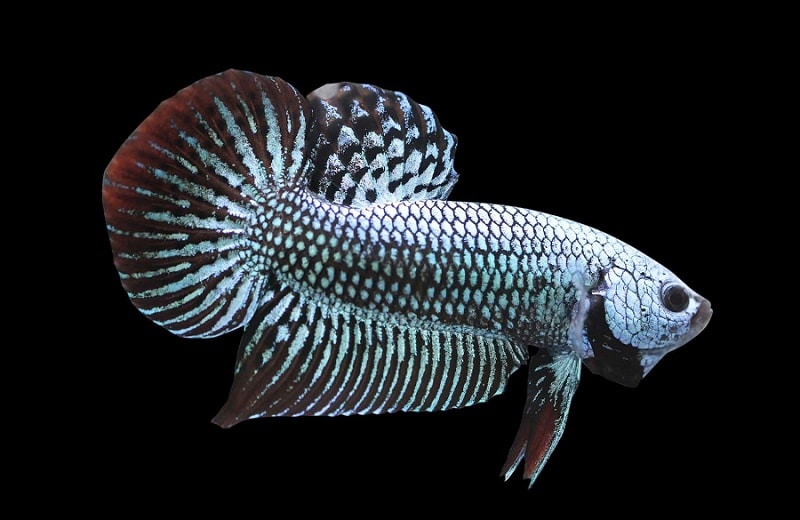
Image purple alien betta fish
Tankmates for Alien Betta
While the male alien betta might have his quarrels with his own kind, he can peacefully coexist with a range of smaller, gentle freshwater fish. Female alien bettas, on the other hand, are more adaptable in terms of tankmates. They can also harmoniously share a space with male alien bettas under the right conditions.
A few tankmates that have proven to be great companions for betta fish include (Cory Catfish, Ghost Shrimp, Cardinal Tetras, Kuhli Loaches) ensure a peaceful coexistence with the alien betta.
Alien Betta: Habitat and Care
Water Conditions
To ensure your Alien Betta thrives, paying close attention to its environment is paramount. These captivating creatures have specific preferences when it comes to water conditions.
Temperature Requirements
Alien Bettas are comfortable in waters that mimic their natural habitats. Aim for a temperature spectrum between 75°F and 80°F (24°C to 27°C). A consistent temperature within this range creates a comfortable and stress-free environment for them.
pH Levels: Striking the Balance
The acidity or alkalinity of the water, represented by its pH level, is another vital factor. Alien Bettas prefer a slightly acidic to neutral environment. A pH level for betta ranging from 6.5 to 7.5 is ideal. Ensure you have a reliable pH test kit on hand to monitor these levels accurately.
Routine Maintenance
Regular maintenance is the cornerstone of a thriving aquarium. Perform regular water changes and consistently keep an eye on the tank’s conditions. In doing so, you not only safeguard the water’s cleanliness but also sustain a habitat that promotes the health and well-being of your Alien Betta.
While the Alien Betta is a resilient and adaptable fish, offering them a well-maintained habitat aligns with their natural needs and ensures they live a long, happy life in your care.
Alien Betta: Diet
The Alien Betta boasts a carnivorous diet, relishing the flavors and nutrition from meaty sources Bloodworms, brine shrimp and Mosquito Larvae.
Feeding Recommendations: To keep your Alien Betta energetic and healthy, offer food in small portions twice a day. This mimics their natural feeding pattern and prevents overfeeding which can lead to health issues and water contamination.
Alien Bettas: Gender Differences (Male vs. Female)
1. Alien Bettas Males
- Vibrant Colors: One of the most distinguishing features of male Alien Bettas is their brilliant coloration, which often outshines their female counterparts. This radiant display can be both a sign of good health and a method of attracting mates.
- Fins: Male Alien Bettas take pride in their long, flowing fins, which add to their majestic appearance and are a spectacle during their swimming and courting displays.
- “Beard” Feature: Underneath their gill coverings, males have a more pronounced “beard.” This feature is not as noticeable in females.
- Size: Males are generally larger, giving them a more dominating presence in the tank.

2. Alien Bettas Females
- Fins: Unlike the males, female Alien Bettas have shorter fins, which give them a more streamlined appearance.
- Mating Indicators: When females are ready to mate, they exhibit vertical stripes. Additionally, an “egg spot” becomes visible, indicating their readiness to reproduce.

How to Breed Alien Betta?
Breeding Alien Bettas can be an intricate process, but with patience and understanding, it can also be a rewarding experience. Here’s a step-by-step guide to help you through it.
Pairing Based on Coloring
To ensure offspring that maintain the distinct and desired appearance of the Alien Betta, it’s essential to pair males and females with similar coloring. This increases the chances of producing offspring with consistent and attractive hues.
Creating the Right Environment
The male Alien Betta prefers having a selection of females to choose from for breeding. Introducing multiple females can make the male more inclined to start the breeding process and can reduce potential aggression.
The Art of the Bubble Nest
When the male is ready to breed, he exhibits a fascinating behavior – the construction of a bubble nest. This is created by blowing bubbles that float to the water’s surface, forming a protective layer. This nest signals his readiness to mate and serves as a sanctuary for the forthcoming eggs.
The Mating Dance
Once the bubble nest is established, the male will actively court a chosen female. After the courtship, the female will release her eggs, which the male will promptly collect.
Safeguarding the Eggs
Taking on a protective role, the male carefully places the eggs within the safety of his bubble nest. This nurturing act ensures the eggs are sheltered and oxygenated as they develop.
The Dawn of New Life
In a matter of 2-3 days, the magic happens. The once tiny eggs evolve into wriggling fry, marking the onset of a new generation of Alien Bettas.
Breeding Alien Bettas requires attention to detail, a conducive environment, and a touch of patience. However, witnessing the marvel of new life makes the journey well worth it.
Source: Aqua Diary
Final Thoughts
The journey into the world of Alien Betta is a blend of fascination, responsibility, and fulfillment. Armed with knowledge and understanding, you’re now well-prepared to decide if these mesmerizing fish align with your aquarium aspirations.
Remember, every aquatic life you introduce into your home is both a commitment and a privilege. Alien Bettas, with their radiant hues and unique behaviors, can be a captivating addition to your underwater haven.
If you’ve found this guide enlightening, don’t hesitate to explore more informative blogs from National Park Aquarium. Dive deeper into the aquatic realm with us and discover the beauty and intricacies of underwater life.














